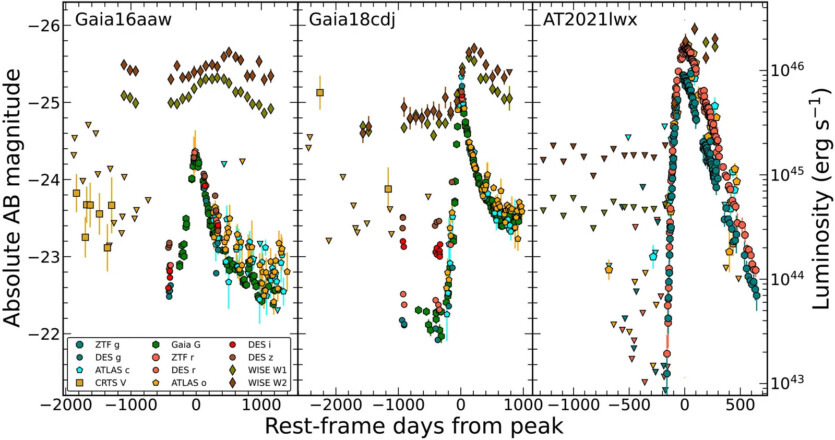
Astronomers from the University of Hawaii have discovered a completely new class of powerful cosmic phenomena with the release of enormous amounts of energy due to the death of supermassive stars.
These phenomena are already called extreme nuclear transits, or ENTs for short. They occur when a supermassive star, several times larger than the Sun, comes too close to a black hole.
«We have been observing stars being torn apart by tidal forces for more than a decade, but ENTs are beasts of a different order. Their brightness is almost ten times higher than typical events of this kind! Not only are ENTs much brighter than normal tidal disruptions, but they continue to glow for many years, far exceeding the energy release of even the brightest known supernova explosions», — explains the study leader Jason Hinkle.
Astronomers have discovered for the first time signs of ENT, studying data from the Gaia telescope mission. They noticed two mysterious flashes, called Gaia16aaw and Gaia18cdj and did not correspond to any of the scenarios observed before. Their light curves were smooth and gradually became brighter, in sharp contrast to the disorderly flickering of typical black hole flares or sudden supernovae.
A third such outbreak, AT2021lwx, was independently detected as a result of a wide-angle astronomical survey of the sky using a new camera attached to the Samuel Oshin Telescope at the Palomar Observatory in San Diego County, California (Zwicky Transient Facility). In particular, the most striking of the Gaia18cdj events highlighted 2.5 × 10⁵³ erg of energy — 25 times more than the most powerful supernovae known. An ordinary supernova emits as much energy during a year as the Sun is capable of producing in all 10 billion years of its existence.

The researchers focused on studying the process of destruction of supermassive stars that are too close to black holes in the galactic centers. These stars are literally torn apart. For some time, the fragments of the star form an accretion disk around the black hole, which gradually absorbs them. Usually, when a black hole absorbs gas from the surrounding space, its glow changes rather chaotically and unpredictably. But ENTs show a surprisingly smooth and long-lasting outburst. Scientists believe that this is due to the fact that the black hole is slowly absorbing the remains of an entire, recently exploded star.
To confirm this hypothesis Jason Hinkle, along with a team of astronomers, has been observing ENT for many years, connecting the Hawaiian ATLAS system, Keck Observatory, and a large number of telescopes around the world.
The spectra of ENTs showed emission of hot blue light and broad hydrogen lines, a sign of high-energy accretion into a black hole. The galaxies that hosted these supermassive black holes and stars had a redshift of about 1, indicating that the ENTs occurred around 7-8 billion years ago, when star formation and black hole growth were at their maximum.
However, events such as ENTs are extremely rare and occur at least 10 times less frequently than supernova explosions. For them to occur, a supermassive star must exist in the central region of the galaxy, drifting slowly toward a black hole, which destroys it but does not immediately absorb it.
New telescopes such as the Vera Rubin Observatory in Chile and NASA’s Roman Space Telescope are expected to start searching for ENTs in the coming years. This will help scientists finally understand how black holes live and evolve, as well as learn a lot about the early Universe.
Scientists reveal 30-year secret of huge X-ray flares of black holes
The results of the study are published in the journal Science Advances
Source: ZMEScience

Spelling error report
The following text will be sent to our editors: